Captain William Hicks, USN Ret.
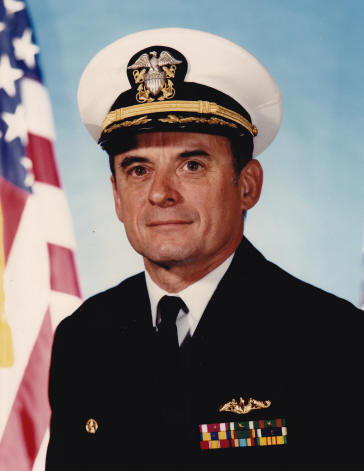
Read Part 8
What Changed During My Career?
Over a 30 year career, many things changed. It is interesting to consider the more significant changes and how they have affected submarine operations moving into the 21st century with a new enemy and new tactical and strategic demands on the force:
Navigation
Navigation in the context of this discussion involves both the ability to determine where the submarine is located using external sources as well as the ability to determine the location at all times by dead reckoning or plotting the track being followed without external data. During my career, both aspects of navigation advanced significantly.
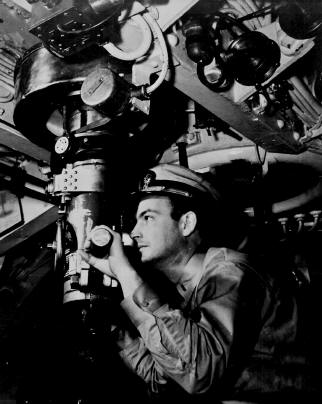 During the special operations on Sargo when we grounded, the ability to obtain a navigational fix from external sources was limited to star sights through a periscope is not very accurate, or visual sightings of landmarks on shore. There was essentially no electronic
navigation system available except a tenuous soviet system which was not reliable. At the time we grounded, there had been no fix for two days due to cloud cover and being out of sight of land. Sargo was actually about 12 miles from the dead reckoning position due to currents and the lack of a functioning inertial navigation system.
During the special operations on Sargo when we grounded, the ability to obtain a navigational fix from external sources was limited to star sights through a periscope is not very accurate, or visual sightings of landmarks on shore. There was essentially no electronic
navigation system available except a tenuous soviet system which was not reliable. At the time we grounded, there had been no fix for two days due to cloud cover and being out of sight of land. Sargo was actually about 12 miles from the dead reckoning position due to currents and the lack of a functioning inertial navigation system.
A significant effort was initiated during the development of the Polaris Missile SSBN systems to develop a Ships Inertial Navigation System (SINS). In its most simplistic form, the SINS uses a stable gyro system to maintain a stable north vector and accelerometers to determine the ships speed by integrating the changes sensed by the accelerometers.
Sargo had an early developmental SINS system but it seldom worked. SSBNs had three, more advanced SINS with which they were able to maintain an accurate dead reckoning position frequently updated by fixes using electronic means that were not available in the parts of the Pacific Ocean in which we were conducting the special operations.
Today, everyone is familiar with the Global Positioning System (GPS). When my career started, GPS was not available and would not become available for many years. The predecessor to GPS was the Naval Satellite System (NAVSAT) which was a constellation of satellites that could be individually tracked, when available, to provide positioning information.
NAVSAT functioned by tracking the signal of a passing satellite for about 15 minutes and using Doppler changes and an estimate of position. In this way, it was possible to achieve an accurate fix.
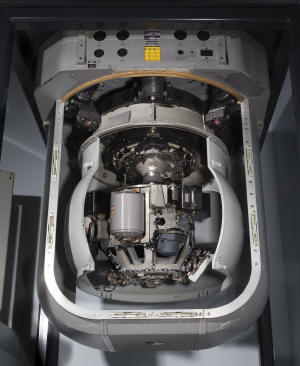 I believe the first NAVSAT I saw was on DACE as a developmental installation that was provided for deployment. With a constellation of GPS satellites, it was no longer necessary to wait for a satellite pass; the accurate fix was nearly instantaneous. SINS also developed to become extremely
accurate and reliable.
I believe the first NAVSAT I saw was on DACE as a developmental installation that was provided for deployment. With a constellation of GPS satellites, it was no longer necessary to wait for a satellite pass; the accurate fix was nearly instantaneous. SINS also developed to become extremely
accurate and reliable.
DACE had no SINS, but Philadelphia had two mini-SINS. Bates had one very reliable SINS which required significant operator understanding of the cyclic nature of the provided track to ensure accurate understanding of the ships position. However, I always felt while in command of Bates that I knew our position within a manageable uncertainty and was
confident of the accuracy of the uncertainty of that position.
By the time I left command, I believe that there was little excuse for a submarine not to have an adequate, continuous knowledge of the ships position at all times. While there are still instances of submarine groundings or violation of submerged separation rules, they are now predominately due to poor seamanship rather than inadequate navigation
policies, equipment or technology. Examples of the poor seamanship include not keeping all charts up to date; not accurately managing position uncertainty when operating submerged; poor or incomplete voyage planning; imprudent navigation team actions; and excess depth or speed in shallow or hazardous waters.
Weapons
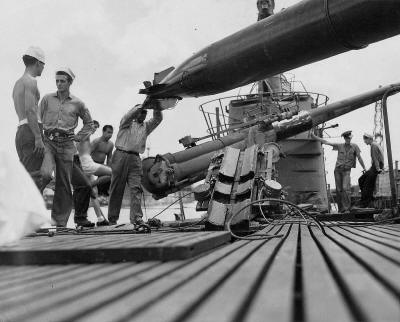 When I reported to Sargo, we had essentially the same weapons used at the end of WWII. Steam driven anti-ship torpedoes (MK 14) and battery powered, slow speed anti-submarine torpedoes (MK 27/37). The fire control system was similar to the ones on the WWII submarines and
required manual calculations of the firing solution for the MK 37 torpedoes. Sargo had six 21 inch torpedo tubes in the forward torpedo room and two smaller tubes in the stern which accommodated only 19 inch electric torpedoes.
When I reported to Sargo, we had essentially the same weapons used at the end of WWII. Steam driven anti-ship torpedoes (MK 14) and battery powered, slow speed anti-submarine torpedoes (MK 27/37). The fire control system was similar to the ones on the WWII submarines and
required manual calculations of the firing solution for the MK 37 torpedoes. Sargo had six 21 inch torpedo tubes in the forward torpedo room and two smaller tubes in the stern which accommodated only 19 inch electric torpedoes.
During my career, I saw the nuclear tipped torpedo (MK 45) come and go as well as the nuclear tipped anti-submarine short range missile (SUBROC). The MK 48 was the major advance in anti-ship and anti-submarine torpedoes. It has progressed through multiple advanced capability improvements but remains the only torpedo.
Torpedo tubes have changed little. The small diameter stern tubes were last on Skate class. The 21 inch hydraulic tubes remain the standard, although there has been discussion of a larger diameter tube to accommodate submerged launching of remote or tethered vehicles for mine clearance or surveillance.
The major advance has been the tactical Tomahawk cruise missiles in its many variants. The initial introduction of the Tomahawk onto submarines occurred in the mid 1980's. The Tomahawk was launched from a torpedo tube. The significant advance was configuring and updating the fire control system to accommodate the targeting requirements for the
Tomahawk. In the initial introduction of the system, portable test equipment was placed on the submarine to control the Tomahawk. Because of the significant tactical capability of the Tomahawk, the development of the fire control system upgrades progressed rapidly.
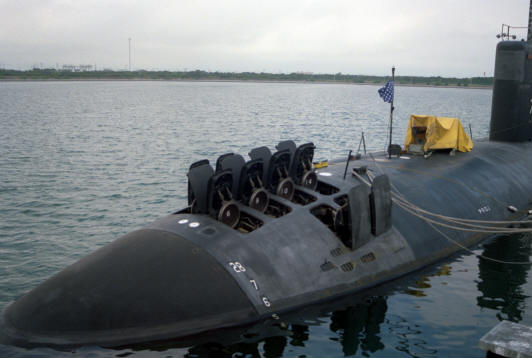
The more revolutionary change for the SSN was the vertical launch system for the Tomahawk in which vertical launch tubes were installed in the submarine forward ballast tanks for the sole purpose of carrying Tomahawk missiles. This increased the number of Tomahawks that could be carried and launched and mitigated the reduction of torpedoes in the
torpedo room, although in some cases, submarines carried Tomahawk in both the vertical tubes and the torpedo room.
The fire control systems and sonar systems have also evolved to significant improvement from Sargo. Digital technology has provided much of the improved capability. In sonar, the digital analysis capabilities have been mated with much more sensitive sensors, both the "big ball" sonar mounted on the bow of the submarine and the long towed array attached
to the stern.
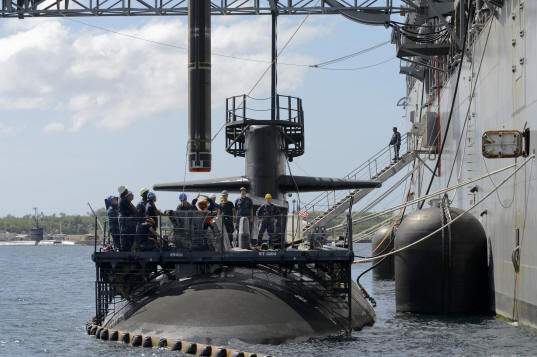
Since my retirement, the improvements in sonar sensors have been even more dramatic as the Wide Aperture Array has been developed and installed on the newest class of submarines (Virginia Class). I watched the individual steps of this evolution from Sargo to Sunfish and Dace and then the major advances on Philadelphia and the submarines in Squadron
Eleven. The first step was usually a standalone test or prototype component which was installed for special operations, deployments, or evaluation exercises. It then evolved into a formal standalone alteration. The capabilities would eventually be integrated into the basic fire control, sonar or navigation systems installed during construction or overhaul.
Since my career was primarily on SSNs, I have not discussed the similar advances in strategic missile systems and capability. From the air breathing Regulus Guided Cruise missile on Halibut and several diesel submarines, to the 1200 mile, single warhead capability of the Polaris Ballistic missile on the George Washington (SSBN 598), to the
multi-thousand mile, multiple independent reentry vehicle (MIRV) warhead Trident II on the Ohio, the advances in capabilities of the strategic submarines has been equally dramatic. The other revolutionary advancement has occurred in special operations support provided by the conversion of four Ohio class SSBNs to SSGNs.
Stealth
A submarine survives by the ability to remain undetected. During WWII, the major detection threat was radar. The German Submarines combated the Allies radar with radar absorbing and scattering materials on the snorkel mast which was extended to get air into the submarine when underway submerged on diesel propulsion. US diesel submarines had the same
stealth adaptations.
For nuclear submarines, the issue with stealth is noise. Submarines track other submarines passively by sound. Thus reduction of the sound signature is a critical success factor. The sound generated by a submarine can also limit the ability of that submarine to hear another. Submarines generate noise through many mechanisms. The rotating machinery such
as pumps, turbines, reduction gears, and more create acoustic energy (noise) that will radiate into the water if a path is present to the hull.
The first few nuclear submarines including Sargo had essentially no isolation between the rotating machinery and the hull. Each class after that had a more sophisticated internal isolation system to keep the machinery noises from transmitting into the water. However, the human element was always a risk since it only took a poorly placed locker,
temporarily stored container, or dropped tool to provide a sound short which negated the sound isolation technology. To work this problem, each ship had a system to check self noise.
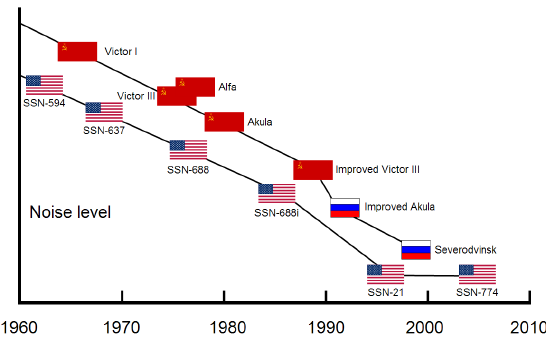
Flow noise was also a detection source when the diesel fleet boat hull traveled at the higher speeds made possible by nuclear power; thus the development of the atear dropÓ hull shape. The propeller is the device that pushes
the ship through the water and through which the thousands of shaft horsepower are dissipated into the ocean. Poor propeller design was a significant source of noise. Over the years the shape and operation of the submarine propeller or propulser have changed significantly to reduce the noise signature. Rattles in the ballast tanks or superstructure outside of the hull also
are a noise source mitigated by improved design. Traditionally, submarines had topside lockers in the sail and the superstructure to store mooring lines, paints, a brow, and other items needed to moor or when on the surface. The locker structure or contents often were the source or rattles that risked detection or limited the speed. Philadelphia had no lockers in the
superstructure and thus eliminated that source of noise. That did require mooring lines be stored below decks or not carried which was a problem in a new or strange port.
Other adaptations such as deflectors on the ballast tank flood ports and closure caps on the sail evolved as noise reduction took on ever greater importance. Active sonar was also a potential source of detection. To combat this risk, hull coatings were developed that similar to the anti radar coatings absorbed or scattered the active sonar signals.
These coatings also acted to reduce the transfer of noise from inside the submarine into the water. In aggregate, the difference in acoustic detectability between Sargo and Philadelphia was dramatic.
Leadership and Operational Philosophy
When I reported to Sargo, the commander of the Pacific Submarine Force was RADM E. B. Fluckey who was awarded the Congressional Medal of Honor for exploits as a submarine commanding officer during WW II. His philosophy was to send the submarines to sea with goals and missions and depend on the crews to carry them out. When Sargo ran aground, his
investigation focused on the tasking in locations with limited navigational aids, the priorities of the missions and he drew the conclusion that when a ship is assigned in those conditions, he was willing to accept unlucky events when no clear dereliction of duty was evident. He was also clearly focused on war fighting capability and when it was determined that many torpedoes
onboard his submarines would not work due to a error in the torpedo shop, he was unforgiving in assigning responsibility and unrelenting in overseeing rapid corrections.
As the years passed, the memories of risk taking and stretching the envelope during WWII faded. In its place, potential political impact both domestic and within the context of the cold war with Russia from any event gained preeminence in the thinking of the leadership of the Submarine Force. Individual initiative was replaced by ever increasing rules.
Rules were designed to avoid incidents but frequently inhibited or supplanted tactical initiative. Frequently mission success was gained by taking risks to skirt or ignore the rules. Success was celebrated, but any incident was judged within the rules which frequently made success unlikely. The improved technology discussed above made untoward events less unavoidable and thus
more the result of command errors or ineffectiveness.
One of the most significant impacts on command independence and initiative was the improvement in communications from Sargo when one-way communications to the submarine was the norm until today when satellite capabilities, make secure two way communications with the submarine routine. No initiative required or desired. Call home and ask!!
Admiral Rickover to Admiral Mckee
When I entered the nuclear power program out of college, Admiral Rickover was in charge and had been since the birth of the program. He was a technical, managerial, and political force whose reputation for being a difficult leader frequently overshadows his genius in other areas. He had an incredible attention to detail with a span of managerial
control that stretched across the entire program from research laboratories to training schools to building and overhaul shipyards to every nuclear ship in the fleet. His representative at each of these organizations wrote periodic letters to him which describe their activities. From these letters he was able to keep his finger on the pulse of the entire organization. He was
not bashful about challenging any decision or inference that his standards were not being met or his representative was taking inappropriate action or decision in his name. He personally interviewed and accepted each officer candidate and revisited and approved each progression within the program to engineer, command and major command. He was a brilliant engineer with an
incredible foresight which allowed him to set radiation and radioactive material limits that over time became industry standards.
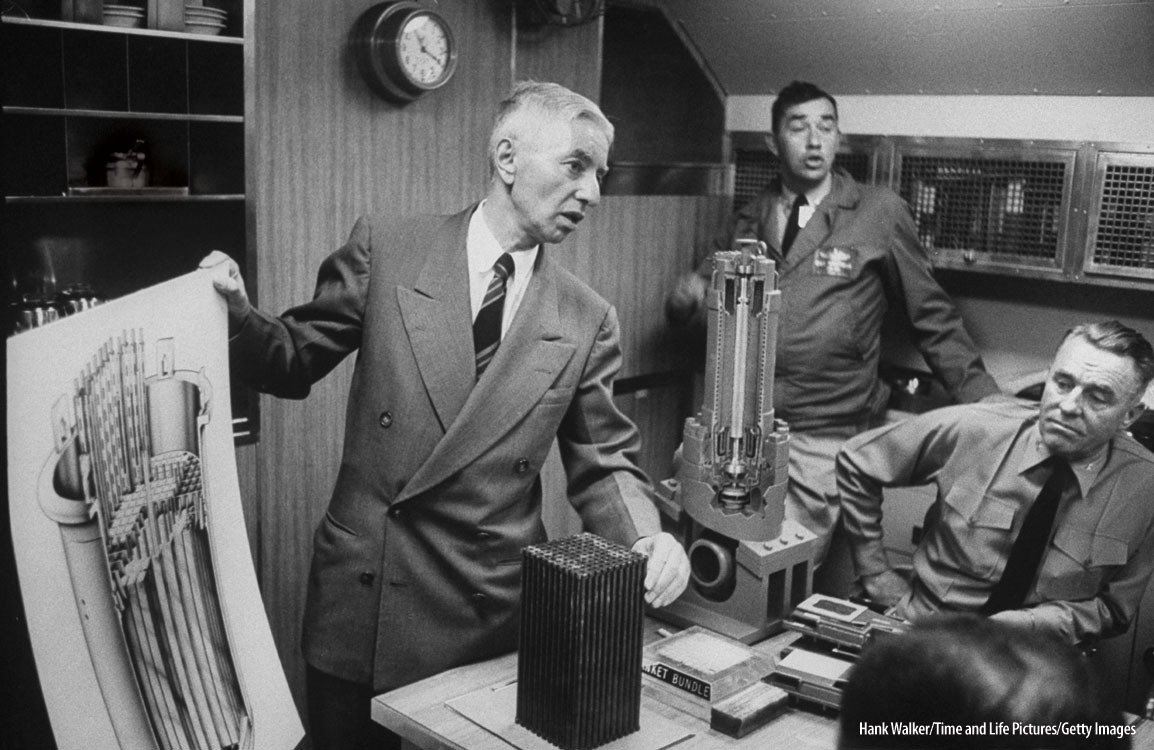
Admiral McKee had a very different background from Admiral Rickover. He was an operator who exploits as Commanding Officer of Dace were celebrated and still classified. He had broad experience at senior policy and command positions until he was selected to replace Admiral Rickover. He embraced the policies and expectations that had been the foundation
of the nuclear propulsion program from its beginning: The strong technical basis, the strict adherence to defined processes and procedures, and the personal involvement in the selection and training of the personnel in the program. However he also brought a much greater concern for operational safety in the face of casualty or war damage. He was in the force when Thresher
sunk and commanded Dace which was the same class with little modification. He was more sensitive to battle damage and additional requirements to save the ship in the face of major casualties. He took action to modify procedures and to modify some ship design features to make the ship more survivable during major casualties.
He was also concerned to ensure the training pipeline was providing personnel who met the standards of performance which was expected in the fleet to the extent that when I was senior member of the NPEB, he requested we conduct an operational reactor safeguards examination of one of the prototype reactors for which he was responsible. He told me it was
his goal to ensure the operational expectations at the prototype were at least as high as our expectations for operational excellence in the fleet. He was disappointed but not surprised when the results were only average. In summary, Admiral Mckee retained the technical and managerial rigor engrained in the program by Admiral Rickover and added an operational emphasis on
controlling and surviving significant casualties and battle damage. It was also my sense that the number of phone calls to individual commanding officers was less, but the written communications from across the complex remained the same.
Observing and having the benefit from the improvements in operational and design philosophy and technology has been fun and enlightening. I am sure the advances continue as the newest classes of SSNs and SSBNs are designed and built. I guess I am a bit sorry that I am not in position to see these advances, but I have done my time and it is appropriate
that someone else have the opportunity to have as great a challenge and as much enjoyment as I had in my Cold War Career.
Ain’t America wonderful? A poor farm boy gets the challenges, thrills and opportunities that I have had and gets paid too. The nuclear navy was truly a challenging and satisfying experience and career: Never dull; Never an opportunity for complacency; always a personal and technical challenge; source of great friends and workmates.
The downside was the impact on the family: Always on the move; few roots; too little time to enjoy life together (I can count the number of true family vacations on the fingers of one hand). What will never be known is how things would have worked out had Sputnik not been launched in 1957. Would I still be on the farm and how would that have worked
out?
From a broader view, I think the nuclear submarine force was critical in keeping the peace throughout the Cold War. We had the SSBN force (to which my only real connection was on the NPEB two days at a time) which was the truly survivable leg of the nuclear triad. The SSNs always placed the Soviet SSBNs in jeopardy and they knew it, which was critical
in preventing an attack. The SSNs were an important contributor to the collection of intelligence upon which national political, diplomatic, and defense decisions were made. As the Cold War wound down and War on Terror ramped up, the SSNs were ready with surveillance and cruise missiles to play a key role.
A life and career truly defined by the Cold War.
Read other articles by Captain William Hicks